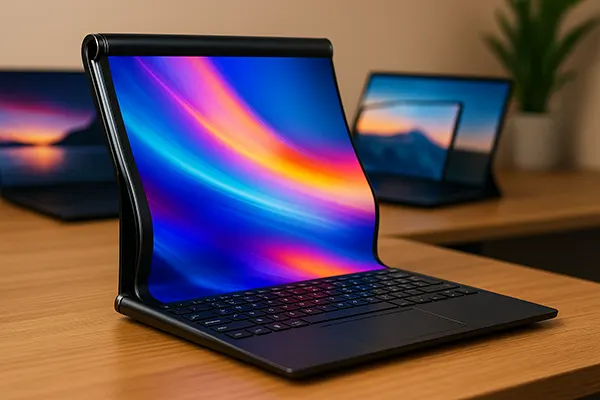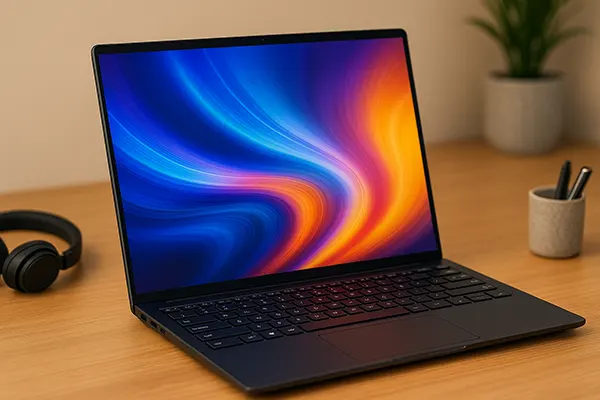
OLED, Flexible, Expandable and Rollable Laptop Displays: A Look at New Form Factors
The evolution of laptop displays has moved beyond just improving resolution and colour accuracy. In 2025, the market is witnessing the rise of innovative form factors such as OLED panels, flexible screens, expandable designs and rollable displays. These cutting-edge technologies are reshaping how users interact with laptops, offering new possibilities for creativity, productivity and entertainment.
The Rise of OLED and Flexible Laptop Screens
OLED displays have become increasingly common in premium laptops due to their vibrant colours, deep blacks and high contrast ratios. These panels are not only visually superior but also more energy-efficient than traditional LCDs, making them ideal for portable devices where battery life matters. In 2025, brands like Dell, Lenovo and HP continue to release flagship models equipped with OLED panels.
Flexible displays represent the next step in display innovation. They use advanced substrates that allow panels to bend without breaking, enabling unique foldable designs. For example, the Lenovo ThinkPad X1 Fold (2024) offers a foldable OLED screen that can transform from a compact tablet-like device into a full laptop with a keyboard attachment.
Such flexibility makes laptops more versatile. Users can fold the screen for reading or sketching, then unfold it for coding or editing large documents. This adaptability is especially beneficial for digital artists, students and professionals who switch between tasks throughout the day.
Practical Benefits and Challenges
The main benefit of OLED and flexible screens is their ability to adapt to various use cases. For example, OLED’s high contrast is excellent for watching HDR content, while flexible displays allow more portable designs without sacrificing screen size. These advantages enhance creativity and user comfort.
However, these technologies face challenges. Flexible displays are still relatively fragile, making them prone to damage from accidental pressure or bending beyond intended limits. They also tend to be heavier because of the protective layers needed to prevent damage, which affects portability.
Cost is another concern. Laptops with OLED or flexible panels are significantly more expensive than traditional models, limiting their adoption to premium market segments. Repairing these screens is also complicated and costly, which can discourage buyers concerned about long-term reliability.
Expandable and Rollable Displays: The Future of Laptop Design
Expandable and rollable displays are pushing the boundaries of what a laptop screen can be. These designs use motorised or sliding mechanisms to extend the display area when needed. This approach allows users to carry a compact device that can transform into a large workstation on demand.
A notable example is the Asus Zenbook 17 Fold OLED, which features a large foldable display that can be partially unfolded or extended for different tasks. Some concept models shown at CES 2024 and 2025 demonstrate rollable panels that slide out from the chassis, increasing the horizontal workspace for multitasking.
Such devices could revolutionise productivity for programmers, video editors and designers, who often require multiple windows or timelines on screen. Having a portable workstation that expands only when needed offers both flexibility and space efficiency.
Engineering Barriers and Reliability Concerns
Despite their potential, expandable and rollable displays face major technical hurdles. Mechanisms must endure thousands of cycles without failing, and ensuring dust resistance is challenging. Any mechanical failure could render the display unusable.
Weight distribution is also a concern. Rollable systems add moving parts, increasing weight and potentially affecting balance during use. Achieving a lightweight yet durable construction remains a key engineering challenge for manufacturers.
Manufacturing costs further slow adoption. Producing flexible OLED substrates and integrating rollable mechanisms involves expensive materials and precise engineering, resulting in high retail prices and low production volumes at this stage.

Market Outlook and Future Developments
Looking ahead, the market for these new form factors is expected to grow gradually as costs decrease and durability improves. Tech giants like Samsung Display, LG Display and BOE are heavily investing in research to make flexible and rollable OLED panels more resilient and affordable.
Analysts predict that hybrid designs—combining foldable and rollable features—could appear by 2027. These would allow users to expand both horizontally and vertically, creating near-desktop-sized workspaces while remaining portable when folded.
Environmental considerations are also shaping development. Manufacturers are exploring recyclable materials and modular repair-friendly designs to reduce electronic waste. Improving repairability could also make these devices more appealing to mainstream consumers.
Long-Term Adoption Prospects
Mass adoption depends on overcoming current technical and cost barriers. Once durability, weight and pricing improve, flexible and rollable laptops could become standard in professional and creative industries, similar to how touchscreens became widespread a decade ago.
Education and enterprise markets may also benefit. Foldable or rollable laptops could replace multiple devices, offering students and employees all-in-one solutions that adapt to different tasks and spaces.
Ultimately, while these devices are still niche in 2025, they showcase the direction of laptop innovation: prioritising adaptability, user comfort and efficient use of space. Their success will rely on ongoing collaboration between display makers, laptop brands and component suppliers.




